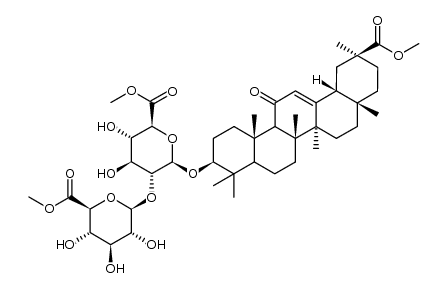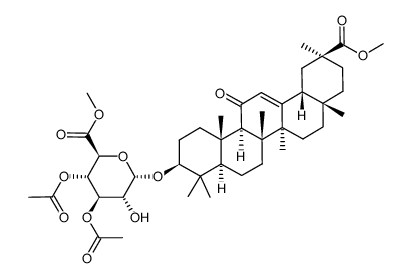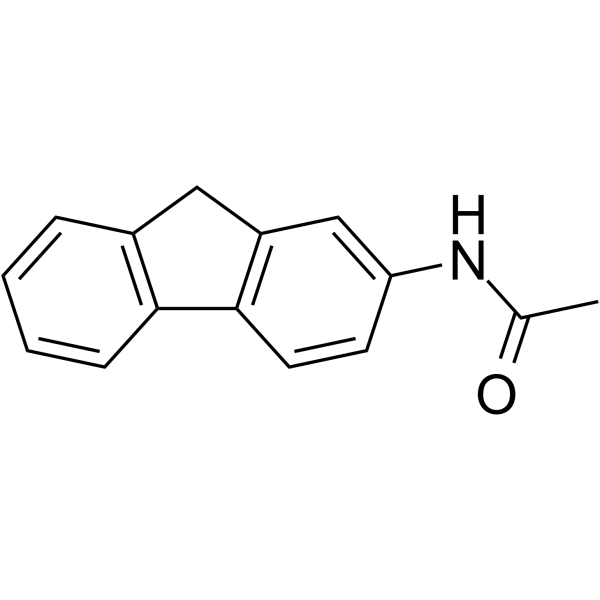Glycyrrhizic acid

Glycyrrhizic acid structure
|
Common Name | Glycyrrhizic acid | ||
|---|---|---|---|---|
| CAS Number | 1405-86-3 | Molecular Weight | 822.932 | |
| Density | 1.4±0.1 g/cm3 | Boiling Point | 971.4±65.0 °C at 760 mmHg | |
| Molecular Formula | C42H62O16 | Melting Point | 220ºC decomposes | |
| MSDS | N/A | Flash Point | 288.1±27.8 °C | |
Use of Glycyrrhizic acidGlycyrrhizic acid is a triterpenoid saponinl, acting as a direct HMGB1 antagonist, with anti-tumor, anti-diabetic activities. |
| Name | glycyrrhizinic acid |
|---|---|
| Synonym | More Synonyms |
| Description | Glycyrrhizic acid is a triterpenoid saponinl, acting as a direct HMGB1 antagonist, with anti-tumor, anti-diabetic activities. |
|---|---|
| Related Catalog | |
| In Vitro | Glycyrrhizic acid shows a series of anti-cancer-related pharmacological activities, such as broad-spectrum anti-cancer ability, resistance to the tissue toxicity caused by chemotherapy and radiation, drug absorption enhancing effects and anti-multidrug resistance (MDR) mechanisms, as a carrier material in drug delivery systems[1]. In intestinal NCI-H716 cells that secretes GLP-1, Glycyrrhizic acid promotes GLP-1 secretion with a marked elevation of calcium levels. Glycyrrhizic acid can enhance GLP-1 secretion through TGR5 activation[2]. |
| In Vivo | In type 1-like diabetic rats induced by streptozotocin (STZ-treated rats), Glycyrrhizic acid increases the level of plasma GLP-1, which is blocked by triamterene at a dose sufficient to inhibit Takeda G-protein-coupled receptor 5 (TGR5)[1]. Glycyrrhizic acid (Glycyrrhizic acid; 50 mg/kg, i.p.) significantly decreases the levels of TgAb, HMGB1, TNF-α, IL-6, IL-1β in mice[3]. |
| Animal Admin | Mice[3] NOD.H-2h4 mice are fed in the animal house until 4 weeks of age. A total of 24 male mice are then randomly separated into three different groups (n=8 per group). Mice in the control group are given sterile water without supplement. Mice in the iodine supplement (NaI) group are given 0.005% NaI in the drinking water. Mice in the NaI+Glycyrrhizic acid group are treated with 50 mg/kg Glycyrrhizic acid once daily for 4 weeks, administered via intraperitoneal injection after 8 weeks of iodine supplementation. Thyroid tissues are removed surgically under anesthesia, washed with cold saline, blotted on filter paper and weighed using an electronic balance. The thyroid gland tissues are then stored at -80°C until use[3]. |
| References |
| Density | 1.4±0.1 g/cm3 |
|---|---|
| Boiling Point | 971.4±65.0 °C at 760 mmHg |
| Melting Point | 220ºC decomposes |
| Molecular Formula | C42H62O16 |
| Molecular Weight | 822.932 |
| Flash Point | 288.1±27.8 °C |
| Exact Mass | 822.403809 |
| PSA | 267.04000 |
| LogP | 4.64 |
| Vapour Pressure | 0.0±0.6 mmHg at 25°C |
| Index of Refraction | 1.621 |
| InChIKey | LPLVUJXQOOQHMX-QWBHMCJMSA-N |
| SMILES | CC1(C(=O)O)CCC2(C)CCC3(C)C(=CC(=O)C4C5(C)CCC(OC6OC(C(=O)O)C(O)C(O)C6OC6OC(C(=O)O)C(O)C(O)C6O)C(C)(C)C5CCC43C)C2C1 |
|
Section 1. Chemical Product and Company Identification Glycyrrhizic Acid Common Name/ Trade Name Glycyrrhizic Acid Section 4. First Aid Measures Check for and remove any contact lenses. In case of contact, immediately flush eyes with plenty of water for at least
Eye Contact 15 minutes. Cold water may be used. Get medical attention if irritation occurs. Wash with soap and water. Cover the irritated skin with an emollient. Get medical attention if irritation develops. Skin Contact Cold water may be used. Serious Skin ContactNot available. If inhaled, remove to fresh air. If not breathing, give artificial respiration. If breathing is difficult, give oxygen. Get Inhalation medical attention. Not available. Serious Inhalation Do NOT induce vomiting unless directed to do so by medical personnel. Never give anything by mouth to an Ingestion unconscious person. Loosen tight clothing such as a collar, tie, belt or waistband. Get medical attention if symptoms appear. Not available. Serious Ingestion Section 5. Fire and Explosion Data Flammability of the Product May be combustible at high temperature. Auto-Ignition Temperature Not available. Not available. Flash Points Not available. Flammable Limits These products are carbon oxides (CO, CO2). Products of Combustion Fire Hazards in Presence of Slightly flammable to flammable in presence of heat. Various Substances Risks of explosion of the product in presence of mechanical impact: Not available. Explosion Hazards in Risks of explosion of the product in presence of static discharge: Not available. Presence of Various Substances SMALL FIRE: Use DRY chemical powder. Fire Fighting Media LARGE FIRE: Use water spray, fog or foam. Do not use water jet. and Instructions Not available. Special Remarks on Fire Hazards Not available. Special Remarks on Explosion Hazards Section 6. Accidental Release Measures Use appropriate tools to put the spilled solid in a convenient waste disposal container. Finish cleaning by spreading Small Spill water on the contaminated surface and dispose of according to local and regional authority requirements. Use a shovel to put the material into a convenient waste disposal container. Finish cleaning by spreading water on Large Spill the contaminated surface and allow to evacuate through the sanitary system. Glycyrrhizic Acid Section 7. Handling and Storage Keep away from heat. Keep away from sources of ignition. Empty containers pose a fire risk, evaporate the residue Precautions under a fume hood. Ground all equipment containing material. Do not ingest. Do not breathe dust. If ingested, seek medical advice immediately and show the container or the label. Keep away from incompatibles such as oxidizing agents. Keep container tightly closed. Keep container in a cool, well-ventilated area. Storage Section 8. Exposure Controls/Personal Protection Use process enclosures, local exhaust ventilation, or other engineering controls to keep airborne levels below Engineering Controls recommended exposure limits. If user operations generate dust, fume or mist, use ventilation to keep exposure to airborne contaminants below the exposure limit. Personal ProtectionSafety glasses. Lab coat. Dust respirator. Be sure to use an approved/certified respirator or equivalent. Gloves. Personal Protection in Case Splash goggles. Full suit. Dust respirator. Boots. Gloves. A self contained breathing apparatus should be used to avoid inhalation of the product. Suggested protective clothing might not be sufficient; consult a specialist BEFORE of a Large Spill handling this product. Not available. Exposure Limits Section 9. Physical and Chemical Properties Solid. (Crystals solid. Crystalline solid.)Not available. Physical state andO dor appearance Intensely sweet. Taste 822.94g/mole Molecular Weight Not available. Color Not available. pH (1% soln/water) Not available. Boiling Point 200°C (392°F) Melting Point Decomposition Temperature: 220 deg. C. Not available. Critical Temperature Not available. Specific Gravity Not applicable. Vapor Pressure Not available. Vapor Density Not available. Volatility Not available. Odor Threshold The product is more soluble in oil; log(oil/water) = 2.8 Water/Oil Dist. Coeff. Not available. Ionicity (in Water) See solubility in water. Dispersion Properties Easily soluble in hot water. Solubility Partially soluble in cold water. Freely soluble in alcohol. Very slightly soluble in diethyl ether. Glycyrrhizic Acid Section 10. Stability and Reactivity Data The product is stable. Stability Not available. Instability Temperature Conditions of Instability Excess heat, incompatible materials Incompatibility with various Reactive with oxidizing agents. substances Not available. Corrosivity Not available. Special Remarks on Reactivity Not available. Special Remarks on Corrosivity Will not occur. Polymerization Section 11. Toxicological Information Inhalation. Ingestion. Routes of Entry Acute oral toxicity (LD50): 4320 mg/kg [Mouse]. Toxicity to Animals Chronic Effects on Humans Not available. Other Toxic Effects onSlightly hazardous in case of skin contact (irritant), of ingestion, of inhalation. Humans Not available. Special Remarks on Toxicity to Animals May affect genetic material (mutagenic) Special Remarks on Chronic Effects on Humans Special Remarks on otherAcute Potential Health Effects: Toxic Effects on HumansSkin: May cause skin irritation. Eyes: May cause eye irritation. Inhalation: Ma y cause respiratory tract irritation. Ingestion: May affect behavior/central nervous system (convulsions, muscle weakness), respiration (respiratory stimulation). Chronic Potential Health Effects: Prolonged or repeated ingestion may affect behavior (symptoms similar to that of acute ingestion), urinary system/kidneys (Proteinuria, myoglobinuria, acute renal failure), metabolism (metabolic alkalosis), blood (change in serum compostion), immune system (decrease in immune response), endocrine system. Section 12. Ecological Information Not available. Ecotoxicity Not available. BOD5 and COD Products of Biodegradation Possibly hazardous short term degradation products are not likely. However, long term degradation products may arise. The product itself and its products of degradation are not toxic. Toxicity of the Products of Biodegradation Not available. Special Remarks on the Products of Biodegradation Glycyrrhizic Acid Section 13. Disposal Considerations Waste must be disposed of in accordance with federal, state and local environmental control Waste Disposal regulations. Section 14. Transport Information Not a DOT controlled material (United States). DO T Cl assi fi cati on Not applicable. Identification Not applicable. Special Provisions for Transport DO T (Pi ctograms) Section 15. Other Regulatory Information and Pictograms TSCA 8(b) inventory: Glycyrrhizic Acid Federal and State Regulations California prop. 65: This product contains the following ingredients for which the State of California has found to California cause cancer which would require a warning under the statute: No products were found. Proposition 65 Warnings California prop. 65: This product contains the following ingredients for which the State of California has found to cause birth defects which would require a warning under the statute: No products were found. Other RegulationsEINECS: This product is on the European Inventory of Existing Commercial Chemical Substances (EINECS No. 215-785-7). Canada: Listed on Canadian Domestic Substance List (DSL). China: Listed on National Inventory. Japan: Listed on National Inventory (ENCS). Korea: Listed on National Inventory (KECI). Philippines: Listed on National Inventory (PICCS). Australia: Listed on AICS. WHMIS (Canada) Not controlled under WHMIS (Canada). Other Classifications This product is not classified according Not applicable. DSCL (EEC) to the EU regulations. Health Hazard HMIS (U.S.A.)1 National Fire Protection 1 Flammability 1 Association (U.S.A.) Fire Hazard 1 0 Reactivity Health Reactivity0 Specific hazard Personal Protection E WHMIS (Canada) (Pictograms) DSCL (Europe) (Pictograms) Glycyrrhizic Acid TDG(Canada) (Pictograms) ADR (Europe) (Pictograms) Protective Equipment Gloves. Lab coat. Dust respirator. Be sure to use an approved/certified respirator or equivalent. SECTION 16 - ADDITIONAL INFORMATION N/A |
CHEMICAL IDENTIFICATION
HEALTH HAZARD DATAACUTE TOXICITY DATA
MUTATION DATA
|
| Hazard Codes | Xi |
|---|---|
| Safety Phrases | S22-S24/25 |
| RIDADR | NONH for all modes of transport |
| RTECS | MD2025000 |
| HS Code | 1211903600 |
|
~% 
Glycyrrhizic acid CAS#:1405-86-3 |
| Literature: Chemical and Pharmaceutical Bulletin, , vol. 42, # 5 p. 1016 - 1027 |
|
~% 
Glycyrrhizic acid CAS#:1405-86-3 |
| Literature: Chemical and Pharmaceutical Bulletin, , vol. 42, # 5 p. 1016 - 1027 |
|
~% 
Glycyrrhizic acid CAS#:1405-86-3 |
| Literature: Chemical and Pharmaceutical Bulletin, , vol. 42, # 5 p. 1016 - 1027 |
| HS Code | 1211903600 |
|---|
| Glycyrrhizin |
| Olean-12-en-30-oic acid, 3-[(2-O-β-D-glucopyranuronosyl-α-D-glucopyranuronosyl)oxy]-11-oxo-, (3β)- |
| Potenlini |
| Glycyrrhizate |
| glycyron |
| DerMacrin |
| MFCD00167400 |
| 20b-Carboxy-11-oxo-30-norolean-12-en-3b-yl-2-O-b-D-glucopyranuronosyl-a-D-glucopyranosiduronic Acid |
| (3β)-30-Hydroxy-11,30-dioxoolean-12-en-3-yl 2-O-β-D-glucopyranuronosyl-α-D-glucopyranosiduronic acid |
| Glycyrrhizic acid |
| Glycyrrhizine |
| liquorice |
| (3b,20b)-20-Carboxy-11-oxo-30-norolean-12-en-3-yl 2-O-b-D-Glucopyranuronosyl-a-D-glucopyranosiduronic Acid |
| 30-Noroleanane, α-D-glucopyranosiduronic acid deriv |
| glycyrrhizinic acid |
| glycyrrhetinic acid glycoside |
| Glycyrrhitin |
| Glycyrrhizic |
| EINECS 258-887-7 |



 CAS#:6556-12-3
CAS#:6556-12-3 CAS#:471-53-4
CAS#:471-53-4 CAS#:53-96-3
CAS#:53-96-3
